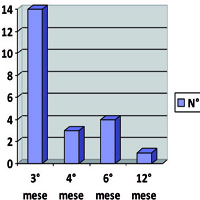Autologous peripheral blood mononuclear cells from selective filtration for treatment of chronic lower limb lesions: Results at 4 years

Submitted: October 13, 2020
Accepted: March 30, 2021
Published: July 30, 2021
Accepted: March 30, 2021
Abstract Views: 395
PDF (Italiano): 218
PDF: 55
Appendix (Italiano): 0
PDF: 55
Appendix (Italiano): 0
Publisher's note
All claims expressed in this article are solely those of the authors and do not necessarily represent those of their affiliated organizations, or those of the publisher, the editors and the reviewers. Any product that may be evaluated in this article or claim that may be made by its manufacturer is not guaranteed or endorsed by the publisher.
All claims expressed in this article are solely those of the authors and do not necessarily represent those of their affiliated organizations, or those of the publisher, the editors and the reviewers. Any product that may be evaluated in this article or claim that may be made by its manufacturer is not guaranteed or endorsed by the publisher.
Similar Articles
- Isabella Lo Castro, The role of the social community networks in the care of chronic wounds , Italian Journal of Wound Care: Vol. 1 No. 1 (2017)
- Giuseppe Nebbioso, C. Albanese, F. Bonat, A. Botta, Giovanni Vito Corona, Cira Costagliola, Corrado Maria Durante, Ciro Falasconi, D. Foglietti, Francesco Giacinto, Pasquale Longobardi, Klarida Hoxha, Cosimo Maglio, Vincenzo Mattaliano, Massimo Menculini, Giovanni Battista Mosti, Carmela Orefice, Sonia Remafedi, Donatella Rossolini, Felice Tafuro, Francesco Petrella, Quality of life study in Wound Care. Final report , Italian Journal of Wound Care: Vol. 1 No. 1 (2017)
- Ciro Falasconi, Vincenzo Amalfi, Patrizia Baroni, Giovanni Vito Corona, Corrado Maria Durante, Paola Fanin, Caterina Favaro, Massimo Fornaciari, Alessandro Farris, Manuela Galleazzi, Francesco Giacinto, Giorgio Guarnera, Vincenzo Lauletta, Mario Marazzi, Marco Masina, Vincenzo Mattaliano, Giovanni Battista Mosti, Giuseppe Nebbioso, Francesco Stanganello, Francesco Petrella, Survey on pain in patients with chronic skin lesions , Italian Journal of Wound Care: Vol. 1 No. 1 (2017)
- Giancarlo delli Santi, Claudio Pilati, Alessandro Borgognone, Simone Tiberti, Peripheral blood mononuclear cells enhance sacral wound healing in a patient with spinal cord injury: a case report , Italian Journal of Wound Care: Vol. 8 No. 3 (2024)
- Aurora Parodi, Valeria Maria Messina, Teresa Cannavale, Stefania Sorbara, Andrea Francesco Pestarino, Emanuele Claudio Cozzani, Management and antisepsis in wound care: The experience of an Italian region (Liguria) in the treatment of older people affected by chronic ulcers , Italian Journal of Wound Care: Vol. 5 No. 2 (2021)
- Fabrizio Moffa, Alberico Balbiano da Colcavagno, Elia Ricci, Use of adipose tissue stem cells in chronic skin lesions: clinical experience , Italian Journal of Wound Care: Vol. 2 No. 2 (2018)
- Francesco Giacinto, Ciro Falasconi, Elisabetta Giacinto, Manuela Germano, Domenica Ciuffoletti, The use of modern technologies based on telemedicine in wound care: experience in high-tyrrhenian region and the province of Cosenza, Italy , Italian Journal of Wound Care: Vol. 2 No. 1 (2018)
- Rolando Tasinato, Paolo Zangrande, Topical treatment with a matrix containing mesoglycan in association with hyaluronic acid in the management of chronic skin ulcers of the lower limbs , Italian Journal of Wound Care: Vol. 3 No. 2 (2019)
- Aurora Parodi, Valeria Maria Messina, Manuela Martolini, Shpresa Haxhiaj, Emanuele Claudio Cozzani, Update on the management and treatment of patients with chronic skin lesions , Italian Journal of Wound Care: Vol. 5 No. 2 (2021)
- Fabio Mozzarelli, Sara Gaetti, Assessment of vascular ulcers of the lower limbs through the Wound Trend Scale: the experience of the Local Health Authority of Piacenza , Italian Journal of Wound Care: Vol. 2 No. 1 (2018)
You may also start an advanced similarity search for this article.


 https://doi.org/10.4081/ijwc.2021.69
https://doi.org/10.4081/ijwc.2021.69



